AI Prompts for Global Learning
Global Education is a broad term encompassing a number of frameworks, pedagogical approaches, approaches to learning and belief systems. While it’s commonly associated with Global Citizenship Education or Global Competence, it can also be approached through any number of means, such as the UN’s Sustainable Development Goals, Peace Education, or even a Social and Emotional Learning (SEL) lens.
We understand that educators and schools are busy, often facing the challenge of a “crowded curriculum.” Given this, it is important to note that Global Education is not an add-on to curriculums, it is already existing within curriculum outlines, objectives, and lessons. When considering how Global Citizenship is addressed in teaching and learning, it is often a matter of adapting and strengthening existing units, to highlight and reinforce opportunities to build Global Capabilities.
“The obligations citizens may consider they have beyond their own national borders as active and informed global citizens.”
– Year 6 Content Description, Civics and Citizenship, The Australian Curriculum
ChatGPT as a Planning Assistant for Global Ed
Generative AI is a subset of AI that produces various content types, such as images, text or even video. This area of technology is rapidly advancing, with new technological abilities emerging almost weekly. There are a number of ways educators can leverage Generative AI (GAI) tools to support Global Learning.
ChatGPT is what many people use, including the team at Meg Languages, but there are many other platforms which yield similar results, such as CoPilot and Bing AI. ChatGPT is a useful assistant for educators who want to align existing lesson plans or units to Global Learning frameworks. It can assist busy educators with building a curriculum that is robust and dynamically aligned to Global Education by providing ideas and assistance with tasks. As with all educational technology, it is important to remember that educators are always the experts and technology can be limited and have flaws, so it should never be relied upon to replace the expertise of an educator.
Let’s take a look at some of the ways we can use ChatGPT (or similar tools) for prompts that can assist in aligning teaching and learning to Global Education frameworks.
Perfect Your Prompt
To achieve the results you’re looking for, consider these basic rules for using ChatGPT:
1. Persona: Providing ChatGPT with a clear persona will help its performance. Using personas such as ‘you are an educator’ will work, but more specific personas are more effective. For instance:
- You are an inquiry-based learning educator
- You are a project-based learning educator
- You are a global citizenship educator (my favourite).
2. Standards: Clearly state which specific standards or curriculum you are using in your prompt, including the grades of students. Be clear about which level you want alignment of standards done.
3. Localise: When prompting for ideas for lessons, including your location can help ensure the suggestions are reflective of your cultural context.
4. Specify: Be specific with your requests. My experience has shown that by chunking requests and tasks, you work with ChatGPT, the more successful the outputs. If you’re not happy with the alignment produced, prompt ChatGPT again, repeatedly if needed, until you get what you want.
5. Clarify Output: As part of your prompt, tell ChatGPT what type of content you’d like, e.g. tables, paragraph, poems, bulleted lists, etc.
Example Prompt:

Global Education Frameworks to Explore
Sustainable Development Goals (SDGs)
As a “shared blueprint for peace and prosperity for people and the planet, now and into the future,” the SDGs are a wonderful way to help students understand that:
- Everyone is needed to build a more peaceful, prosperous, and fairer world for people and the planet.
- It is important to have clear aims for what we are all trying to achieve.
- Working in partnerships makes us stronger and helps us build movements that can achieve great things.
You can leverage ChatGPT here by prompting it to align your learning objectives, unit, or lesson plans to the SDGs. For example:
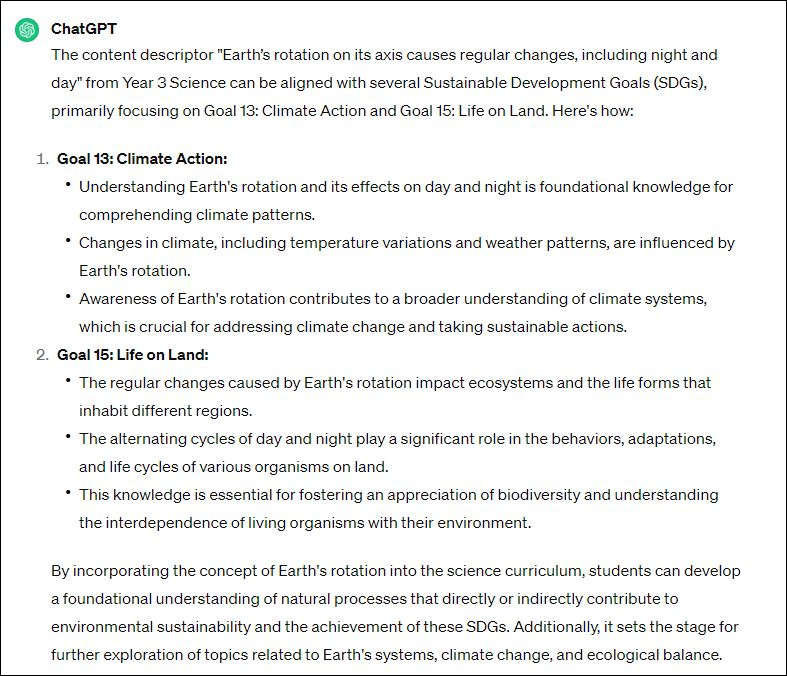
SDG Targets
Each SDG has specific targets which help us understand how to achieve that SDG. As the goals are broad, and with much complexity, the sub-goals play an important role in understanding how the UN sees the goal being achieved.
If we want to get more specific than aligning to the SDGs themselves, we can dig deeper to align to a specific goal’s targets. This may be useful at the high school or tertiary level.
Example Prompt:

Result:
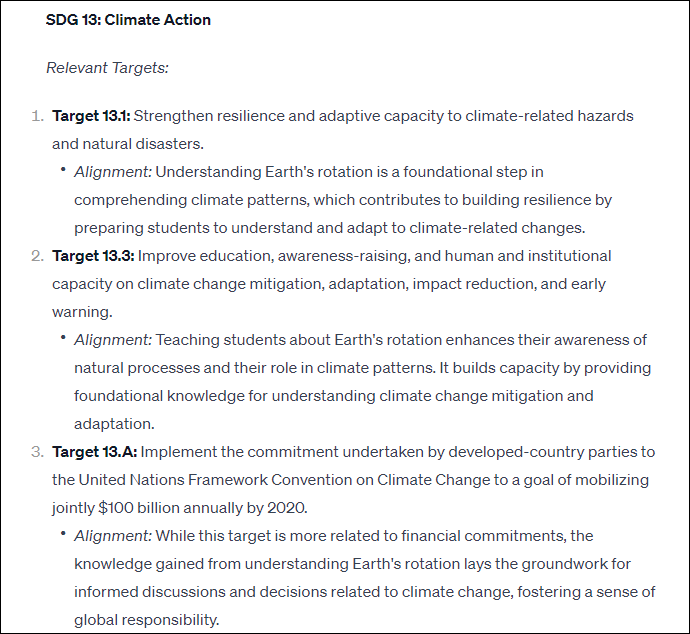
Good Life Goals
Many schools and educators use the SDGs in their curriculum and I often work with schools supporting this work, or introducing the goals to them. One consideration I see time and time again, is that the language of the SDGs, often presented and used with students in primary schools, is not graded for younger learners. It’s important to remember that the SDGs were written at the government level for government departments, businesses, not-for-profits, and, ultimately, for an adult audience. While it is great so many schools use them in their work, they can be too complex for younger learners. Enter: The Good Life Goals.
The Good Life Goals are a simplified version of the SDGs. They are suitable for Primary school students, students with English as a Second Language, or even Secondary students who have been tasked with independent SDG tasks, as a scaffolding support.
You can prompt ChatGPT to align your learning objectives, unit, or lesson plans to the Good Life Goals. Since the Good Life Goals don’t have sub-targets, the alignment will be broad, but with descriptors on how your inputted materials are aligned, it gives further scope for discussion or reflection questions, tasks, etc.
Results:
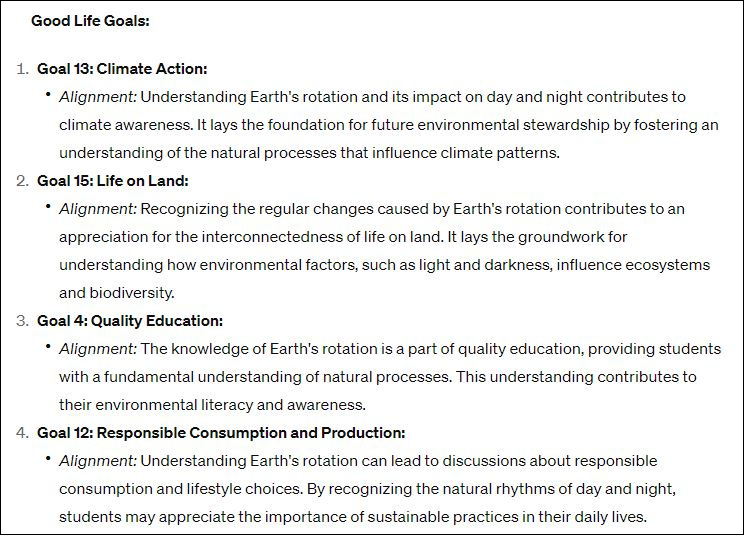
Social Justice Standards
The Social Justice Standards, from Learning for Justice, are a framework for anti-bias education for both Primary and Secondary schools (K-12). With four domains—Identity, Diversity, Justice, and Action—they provide a strong framework for educators wanting to work in anti-bias education.
I prompted ChatGPT to “act as a global educator with expertise in the Social Justice Standards” and then shared the Standards PDF with the Anchor Standards and Domains (only possible with ChatGPT 4). I then asked it to align an existing lesson plan for Chinese culture (Exploring the Local and Global Presence of Chinese Language) to all four domains: Identity, Diversity, Justice, and Inclusion.
The results? I got a good general description of my lesson plan topic that generally fits these concepts. This was a useful orientation task to get my head into the Social Justice Standards.
Given that the lesson is a Grade 6-8 lesson plan, I now want specific alignment to the Grade Level Outcomes for the Diversity Anchor Standard, which is the one I’ve chosen to focus on.
Example Prompt:

Results:
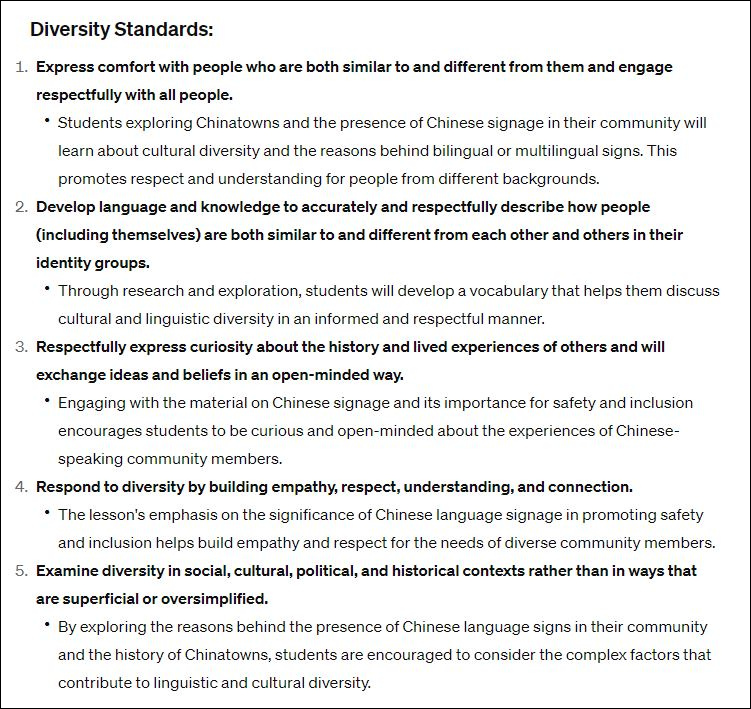
For my lesson planning, I have decided to focus on a couple of standards in more detail, so I then ask which Grade Level Outcomes it aligns more strongly with. I agree with its suggestions!
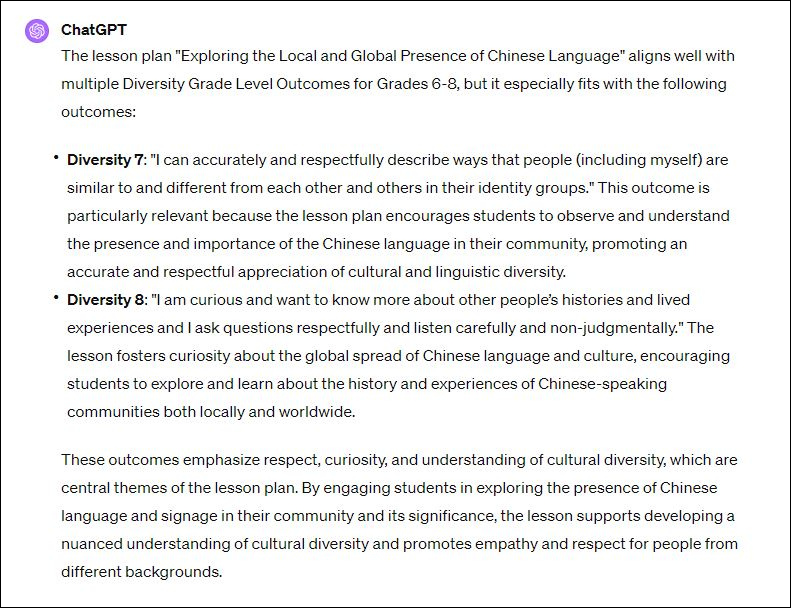
Tips on more general Global Ed alignment
Alongside existing frameworks for Global Ed, there are many other Global Education avenues to explore. Here are a few:
- Taking action: The fourth dimension of PISA’s Global Competence Framework is “Take Action for Collective wellbeing and sustainable development.” ChatGPT can assist here to help brainstorm activities students can do to “take action” in existing units of work. Once you have its suggestions, choose one or two that are suitable and then drill down with further prompting or requests in ChatGPT to flesh out the activities or provide more scaffolding for it.
- Global Collaboration Opportunities: Asking for ideas on different types of Global Collaboration will provide you with a variety of projects from across the curriculum. Suggestions for a search on a Grade 3 and 4 unit on space included; penpals, bi/multilingual topic vocab exchange, art collaborations, virtual science fairs, and virtual tours.
Now it’s time to play and explore! Roll your sleeves up, grab a lesson plan or unit of work, decide on a framework aligned to Global Education that you are familiar with or would like to use, e.g. SDGs, and see what happens when you ask ChatGPT to assist you in aligning your work for a more globally focussed curriculum.
Resources:
Australian Framework for Generative Artificial Intelligence (AI) in Schools
Useful AI in Education Resources:
- AI for Education
- Pedagog.ai
- Teaching with AI
- Artificial Intelligence in Education
- Practical AI Strategies
For a deeper dive into ChatGPT prompting or prompting for Global Ed, explore:

Lottie Dowling is a Primary School trained educator who has worked in a number of education roles internationally for more than 20 years including state schools and international schools in London, China, and NZ. She has worked as a Drama and Literacy specialist, in ESL and EAL roles, and now specializes in Global Citizenship Education. She is currently the Manager of Going Global at Meg Languages.
Share this post

